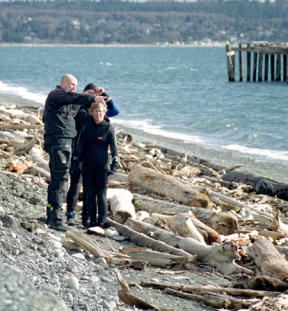Whidbey Island divers looked for octopuses last weekend to help with the Seattle Aquarium’s Puget Sound Octopus Census.
Henry Powers said a group from Whidbey Island Dive Shop submerged Saturday and Sunday looking for the giant Pacific octopus. The group spotted five of the tentacled creatures Saturday and four on Sunday.
Powers knows the undersea territory well, having made almost weekly dives at Keystone Jetty for more than eight years.
Powers said for divers at Keystone Spit, almost every day can be Octopus Day. “But it takes an experienced eye to see an octopus,” he added. “I’ve seen divers looking right at an octopus and not know what they are looking at.”
The animals are elusive, Powers said, because they can camouflage themselves so well. “I don’t see them out on rocks very often,” he said. “Most of the time they are in their lairs.” Powers explained that the cephalopods wrinkle their skin and change its color so they look as much like rock as possible.
“The trick to spotting an octopus is knowing what to look for,” he said. When Powers dives, he looks for sand pushed away next to rocks and for piles of shells.
“They eat crabs and scallops, then spit out the shells,” he said.
While Powers said spotting octopuses at Keystone is “almost guaranteed,” there are times when he “can’t find an octopus for anything.”
Not only can underwater explorers find octopuses at Keystone Jetty, divers also enjoy the all the sea life they can spot as well as the varied diving conditions.
According to Jason Flake of Aqua Sports in Bellingham, Sunday, Feb. 16, was a slow diving day. “Usually you can 25 or 30 people out here,” he said. Fewer than 15 people were suiting up that afternoon. Flake added that windy conditions might have kept people off the beach. Flake dives at Keystone quite a bit because it’s easy to get in to the beach and he always sees great marine life. “Octopus here are always great,” he said. Flake said Keystone is a good place to bring a diving class. “From here, students can get lots of experience with currents and diving conditions,” he said.
Bill and Pauline Jones of Bellingham were preparing to make their second dive and take their final test. They were looking forward to getting in the water. “We always said we would learn to dive once the kids were out and doing well,” Bill Jones said.
“We’re in our second childhood,” Pauline Jones said.
Kelley Scarzafava and Jim Ramaglia from Anacortes Diving also had a group getting ready to dive.
“We come out here to dive a lot,” Scarzafava said. “We bring our classes out to enjoy Keystone conditions,” she said. As Ramaglia reviewed safe diving conditions with the group, Scarzafava said wind wouldn’t stop them from diving.
“About the only thing that will stop us is big surf,” she said. She explained that big waves stir up the bottom and drop visibility. “It’s windy but I think visibility will be good,” Scarzafava predicted.
According to diver Greg Snyder, visibility Sunday morning wasn’t good. “The water was murky and visibility was down to 10 feet,” he said. “I shined my flashlight into rocks and saw octopus hunkered down. They don’t want to be bothered.”
Snyder came from Seattle’s Marker Buoy Club. He enjoys diving at Keystone so much, he has a cabin at Coupeville. Despite gloomy underwater conditions Sunday morning, he was preparing to dive again that afternoon.
While Snyder didn’t think diving conditions were much good, Owen Lloyd and Sonya Baker were enthusiastic after their first dive at Keystone. “It was fantastic,” Lloyd, of Redmond, said as he shrugged off his tank. “This is a great dive site.”
Baker of Puyallup agreed. “We saw lots of fish and took a lot of photographs.” The amateur underwater photographers plan on making return trips to Keystone.
Powers said diving conditions can change quickly at Keystone Jetty. “Within an hour water clarity can go from murky to clear,” he said. Powers always enjoys diving at Keystone. “There’s a lot in the water out there,” he said. He explained that the area has plenty of rocks that create marine habitat. “For a small dive site, you can see just about everything a Puget Sound dive has to offer,” he said.



